SLU
EAS-A193 Class Notes
|
SLU EAS-A193 Class Notes |
|
The fundamental observations used in seismology (the study of earthquakes) are seismograms which are a record of the ground motion at a specific location. Seismograms come in many forms, on "smoked" paper, photographic paper, common ink recordings on standard paper, and in digital format (on computers, tapes, CD ROMs). Careful observation of ground vibrations during the last 80 years or so have lead to our understanding these vibrations, which are caused by seismic waves. We'll discuss waves in more detail in the next section, for now we need a few basics so that we can understand the variety of seismic signals and instruments.
A wave is a disturbance that transfers energy through a medium.
Waves are very common in nature: light is a wave, sound is a wave, ocean surf is generated by waves, and even matter has wave-like properties. The "disturbance" can be an alternating electromagnetic field strength (light), a variation in water height (ocean waves), a variation in material density (sound waves), or a distortion of the shape of the ground (seismic waves).
If you've felt Earth shake during an earthquake or explosion then you've felt seismic waves. These vibrations travel outward in all directions from their source. Waves generated by large earthquakes can be detected throughout the world and are routinely recorded and analyzed by seismologists.
Seismic waves are generated by many different processes:
The range of ground motion amplitudes that are of interest in earthquake studies is very large and seismometers we use are very sensitive. They can detect motions that are much smaller than the thickness of a sheet of paper or as tall as a room. We can detect ground motion in Missouri caused by increased surf activity as a hurricane or large storm system approaches the eastern coast of the lower 48 states.
To understand the difference between these seismic recording instruments, we need to discuss a little about the waves. First, we use the term wavelength the refer to the peak-to-peak distance on a wave measured at a single time - like in a snapshot. To measure the wavelength directly, we would need a group of instruments that measure the amplitude of the wave at the same time but at different locations. If we record the ground motion at a single location for a range of time, we can measure the time between peaks in the motion, which we call the wave period. Another important term is frequency, which is the inverse of the period, or one divided by the peak-to-peak time between wave crests.
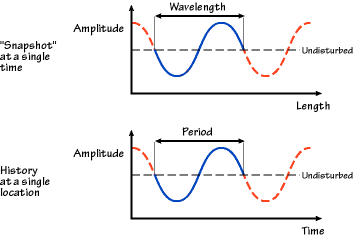
|
|
Waves are energy transmitting phenomena that have an amplitude and a wavelength. The upper panel shows a snapshot of the wave at a single time. The lower panel can be thought of as the motion of a single point for an interval of time. |
The period and the wavelength are related by a simple expression connecting the two with the speed of the wave
Note that the units of the quantities on both sides of the equation balance: wavelength is a measure of distance, such as kilometers, speed is usually specified in terms of kilometers/second, and period is measured in seconds. Checking the physical units of equations is an important way to make sure that you've got the mathematics correct.
The example waves sketched in the cartoon above show a monochromatic, or single-frequency wave, but most interesting signals are actually composites of many frequencies. In many ways seismic vibrations are analogous to light and sound waves so I'll discuss these more familiar waves first.
Light is actually just one of a range of electromagnetic waves that we use each day. Other related waves, which differ primarily from visible light in their wavelength, include microwaves, radar, AM and FM radio, x-rays, etc.
Different colors are actually light waves with different frequencies. For example, red light has a longer wavelength than violet light. The wavelength for red light is about 650 nanometers (billionth of a meter), violet is about 400 nanometers, an x-ray is about 1/3 of a nanometer. FM radio and TV waves have wavelengths around 2-12 meters, AM radio signals have a wavelength of about 30 meters. Perhaps you've heard waves with wavelengths longer than red called infrared and those just shorter than violet called ultra-violet. These terms derive from the wavelength of the colors. TV, VCR, Stereo, etc. remote controls transmit signals in the infrared and high-energy signals like x-rays and ultra-violet radiation are in the part of the spectrum beyond violet.
White light is composed of all visible colors and sunlight contains a large range of the visible spectrum. We could use prism to split the light into it's different color components. The same thing happens when water vapor in the atmosphere is aligned with the rays of light arriving from the sun in just the right geometry, the water vapor acts like a prism and splits the sunlight into a rainbow.

|
|
Observed seismograms like white light, or sunlight are composites of waves of many different frequencies. |
Another common example of a multiple-frequency signals are ever day sounds. Humans can hear frequencies in the ranges of 20 to 20,000 hertz and the musical note "middle A" is around 440 hertz. We can calculate the wavelength of sound waves that we can hear using the formula wavelength = velocity / frequency. In air sound travels at about 340 meters per second (the precise value depends on temperature, humidity, and pressure). We hear (measured in air) range from about two-thirds of an inch to 50 feet.
Much like sunlight contains different colors that can be split apart with a prism, seismic waves contain many different "frequencies" that we can record with specially "tuned" seismometers. The idea is completely analogous with light and sound
|
Seismic |
Light |
Sound |
|
Short-period |
Blue |
Treble |
|
Long-period |
Red |
Bass |
The range of ground motions that are interesting to seismologists is very large because the process of earth deformation occurs at many different rates and scales.
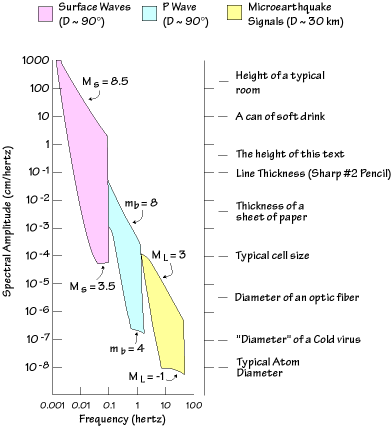 |
|
The amplitude range of interesting signals in earthquake studies as a function of frequency compared with a similar range of physical dimensions of some common items. Since I am comparing the "spectral" amplitude as a function of frequency with physical dimensions of the common items, the analogy is not perfect, but the range of variation in size is well represented. "D" represents the distance from the earthquake. We usually specify large distances over Earth's surface in units of degrees and 1 degree = 111.19 km. |
The large range of amplitudes we are interested in exists because we are interested in all the processes occurring in Earth, from small rock fractures that form in mines to the great earthquakes that occur each year. The amount of energy released by these different processes is enormous, and the large range of interesting amplitudes reflects this.
Seismographs, which generally consist of two parts, a sensor of ground motion which we call a seismometer, and a seismic recording system. Modern seismometers are sensitive electromechanical devices but the basic idea behind measuring ground movement can be illustrated using a simpler physical system that is actually quite similar to some of the earliest seismograph systems.
 |
|
A simple mechanical system that illustrate the basic ideas behind of seismic recording systems. |
The physics behind the sensor is Newton's Law of Inertia:
"A body in motion tends to stay in motion unless acted upon by a force, and a body at rest tends to remain at rest unless acted upon by another force."
The sensor and the recorder do not have to be located next to one another. For example, the recording "drum" in the lobby of the Macelwane Hall records signals from a sensor in the basement. On the 3rd floor of Macelwane Hall, we record signals from sensors distributed throughout the central United States (the center hallway on 3rd floor is open for public viewing 8:30 AM-3:30 PM weekdays).
Seismometers are spread throughout the world, but are usually concentrated in regions of intense earthquake activity or research. These days, the recording system is invariably a computer, custom designed for seismic data collection and harsh weather. Often they are also connected to a satellite communication system. Such systems enable us to receive seismic signals from all over the world, soon after an earthquake.
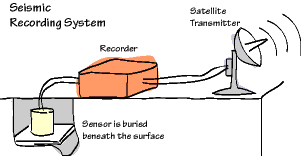 |
|
A real-time seismic recording system with digital storage and satellite communications. Ground vibrations are detected by the sensor, digitally recorded, and then transmitted via satellite. |
For most of the last century, seismograms were recorded on sheet of paper, either with ink or photographically. We call such records "analog" records to distinguish them from digital recordings. These records are read just like a book - from top-to-bottom and left-to-right.
 |
|
The classic paper seismogram is read like a book, from left-to-right and top to bottom. A continuous record is constructed by drawing the line as a sheet of paper fastened to a rotating drum constantly moves horizontally on a threaded attachment. When the ground vibrates the pen moves up or down creating th seismic record of the vibrations. Seismograph station and component, date and start time are recorded on the upper left of this paper. |
One problem with these mechanical systems was the limited range of ground motion that could be recorded - vibrations smaller than a line thickness and those beyond the physical range of the ink pen were lost. To circumvent these limitations we often operated high and low-gain instruments side-by-side, but that was neither as efficient nor effective as the modern digital electronic instruments. However, modern "digital" or computerized instruments are relatively new, only about 15-20 years old, and most of our data regarding large earthquakes are actually recorded on paper (or film). Additionally, we still use paper recording systems for display purposes so we can see what is going on without a computer.
Today, most seismic data are recorded digitally, which facilitates quick interpretations of the signals using computers. Digital seismograms are "sampled" at an even time interval that depends on the type of seismic instrument and the interest of the people who deploy the seismometer. The same principle is used to provide "digital" sound on compact disks. The motion of the ground is continuous, but we can pick only certain positions and reconstruct the motion (within certain limits).
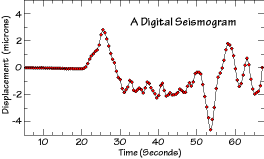 |
|
A digital seismogram is a record of the ground movement stored as an array of numbers which indicate the time and the movement of the ground for a range of times and are easily analyzed using computers. The principle is the same as that used for digital audio signals that are stored on Music CD's. |
Also, since with live in a three-dimensional space, to record the complete ground motion, we must record the motion in three directions. Usually, we usually choose:
With three records of ground motion in three directions, a single seismic station that records about 20 samples per second must store or transmit about
which equals about 5 megabytes per day. For each 200 seismometers of this type around the world, we are recording about
Although we can do better using compression algorithms to save storage, keeping up with this flux of data is a challenge.
Before technological advances in the last few decades, to record seismic signals we developed and deployed many different kinds of seismometers. In the 1960's, as part of an effort to verify underground nuclear test threshold treaties, two seismometer models became standard for global earthquake analyses, the world-wide network long-period and short-period instruments. These instruments have been replaced by "broad-band" instruments which can detect ground motions over large ranges, or "bands", of periods. However, since much of our historical data are recorded on the older "narrow-band" short-period and long-period instruments, they remain important sources of data. Different seismometers record different frequencies (or periods) of ground motion and are analogous to different colors in a picture.
Seismometers are usually designed to record signals over a specified range of frequencies (or periods) so it is convenient to discuss instruments based on the range of vibration frequencies that they can detect. Thus one way to characterize seismometers is to describe the range of vibration frequencies that they can detect. A plot of the amplification as a versus frequency is called an instrument response. An instrument is sensitive to vibrations at frequencies for which the "response" curve is relatively large. Five sample instrument response curves are shown below. The frequency of is shown along the horizontal axis, the equivalent period (period = 1/frequency) is shown along the top horizontal axis. The vertical axis shows the ground-motion amplification factor.
To characterize an instrument, what's really important is the range of amplitudes, not the specific amplification, which is usually adjusted depending on the location of the seismometer. I have used numbers around one to illustrate the differences between the response curves for different instruments but actual amplification factors are usually much larger than those shown.
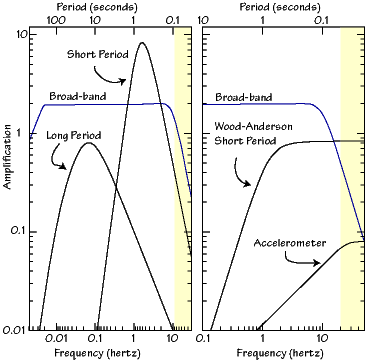
|
|
The broad band instrument senses most frequencies equally well; the long-period and short period instruments are called "narrow" band, because they preferentially sense frequencies near 1/(15 s) and 1 hertz respectively. The yellow region is the low end of the frequency range audible to most humans (we can hear waves around 20 hertz to 20,000 hertz). |
The left panel is a comparison of a modern broadband seismometer response and the classic World-Wide Standard Seismic Network (WWSSN) long- and short-period instruments. The same broad-band response is shown in the right panel, to compare the response with a special short-period instrument, the Wood-Anderson, and an accelerometer. The Wood-Anderson short-period instrument was the one that Charles Richter used to develop his magnitude scale for southern California. The accelerometer is an instrument designed to record large amplitude and high-frequency shaking near large earthquakes. Those are the vibrations that are important in building, highway, etc. design.
The figure below shows the results of different recording instruments on the measurements of ground motion (displacement) for an earthquake that occurred in Texas, in 1995. The observations were recorded on a broad-band instrument and the signals that would have been recorded on the WWSSN instrument types were simulated using a little mathematics since all the vibrations that would be detected by the long- and short-period seismometers are also recorded by the broadband seismometer.
|
|
|
The above diagram shows the ground displacement observed near Tucson, Arizona, caused by an earthquake in southwestern Texas. The top panel shows the vibrations measured using a broad-band seismometer, the middle panel shows the vibrations as they would be detected by the long-period sensor, and the bottom panel the vibrations that would be sensed by a short-period sensor (scaled by a factor of 10 so we can see them better). The displacements are shown in microns, which are 1x10^-6 meters. |
Another important class of seismometers was developed for recording large amplitude vibrations that are common within a few tens of kilometers of large earthquakes - these are called strong-motion seismometers. Strong-motion instruments were designed to record the high accelerations that are particularly important for designing buildings and other structures. An example set of accelerations from a large earthquake that occurred in near the coast of Mexico in September of 1985 are shown in the diagram below.
|
|
|
The above diagram shows the ground displacement recorded at a strong-motion seismometer that was located directly above the part of a fault that ruptured during the 1985 Mw = 8.1, Michaocan, Mexico earthquake. |
The left panel is a plot of the three components of acceleration (one vertical and two horizontal). From the curve we can see that strong, high-frequency shaking lasted almost a minute in the region. The peak acceleration was about 150 cm/s^2. Often we will report such numbers as a fraction of the gravitational acceleration at Earth's surface, which we call "g" and which is about 980 cm/s^2. Thus the peak acceleration in this region was about 150/980 g, or about 0.15g, or equivalently 15% of g.
One place with which we are all familiar with acceleration changes is an elevator. The acceleration that you experience in an elevator is about 2 m/s^2 or about 0.2g. However, in an elevator the transition from 0g (not moving) to 0.2g is smooth and comfortable. During the earthquake, you can see that the ground accelerations were varying between -0.1g to +0.1g several times each second, for at least 10-15 seconds. That is not very gentle shaking.
The middle panel shows the velocity of ground movement, which we can calculate using calculus - the velocity is the integral of the acceleration. The peak velocity for this site during that earthquake was about 20-25 cm/sec. And if we integrate the velocity, we can compute the displacement, which is shown in the right-most panel. From the displacement plot, we can see that the permanent offsets near the seismometer were up, west, and south, for a total distance of about 125 centimeters (since the ground displacement is a vector and the seismograms show the three components of that vector, we must use the vector length to specify ground offset, which is the square root of (50^2 + 50^2 + 100^2)).
Seismic recording systems monitor the ground movements continuously and we have records of the motion of the ground at some places dating back nearly 100 years. Many institutions have been monitoring earthquake activity since the development of seismometers and for example, Caltech and UC Berkeley have relatively long histories of monitoring California seismic activity. At Saint Louis University, Father Macelwane and his students operated a seismic station on campus since around 1911 and we have preserved seismograms for many of the large earthquakes that occurred since then. In 1974, Father Stauder (now one of the University vice presidents) initiated a regional monitoring program to study seismic activity in the central US in general, and the New Madrid region in particular. That work continues and we are about to upgrade the 1970's instruments with modern, broader-band digital equipment.
International monitoring of earthquakes also has a long history. I mentioned the WWSSN that was deployed by the US Government in the 1960's to monitor nuclear explosions and help verify nuclear test treaties since the 1960's. Several smaller networks were deployed before then and today's global seismic network is a cooperative, international effort that consists of more than 100 seismic recording stations.
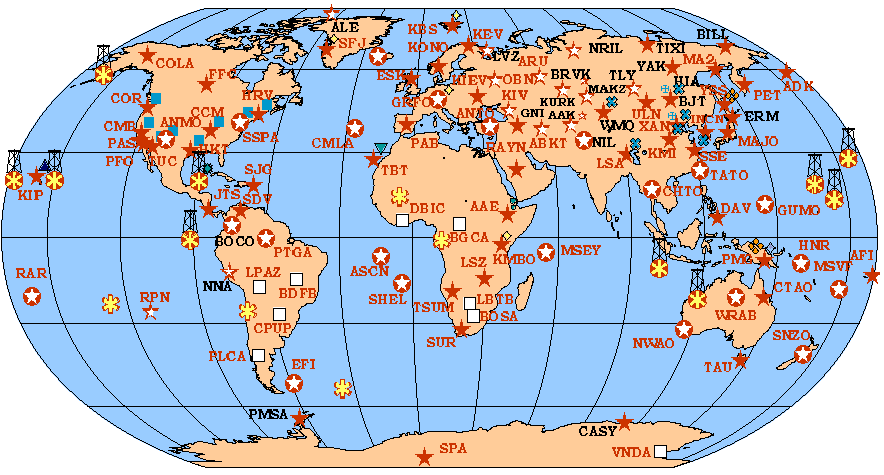 |
|
Locations of seismic recording stations that are part of the Global Seismic Network - a cooperative federation of international seismology organizations that share data. Click here to go to the Incorporated Institute for Seismology (IRIS) WWW site where the original map and many details about each station can be accessed. |
|
|
The data from many of these seismometers are available for rapid analysis following most large earthquakes. They can be downloaded from the INTERNET and quickly processed on computers. Click here to visit the US branch of the Global Seismic Network at the IRIS Web Site. From seismograms we can quickly estimate an earthquake origin time (when the rupture began), location (it's depth, latitude, and longitude), and faulting parameters such as as strike, dip, and slip directions. The US Geological Survey routinely locates earthquakes. You can see a list of the most recent events here (click on the event links to see a map). The seismology group of Harvard has a continuing research contract to "model" all large earthquakes. In addition, for most large events they provide a quick estimate of the faulting parameters - often within a few hours of the earthquake. You can see their catalog of "earthquake solutions" or view a map with focal mechanisms for recent events. Click here to visit to the Harvard Seismology Earth Solutions Project Site. Regional seismometer networks are also operating continuously. Two of the longest operating are UC Berkeley and Caltech. Visit those sites if you have time or need some information on California Earthquakes. A comprehensive list of seismology sites is maintained by Steve Malone at the University of Washington so if you are looking for information from a specific region - try Steve's list. |
Closer to home - Saint Louis University and the University of Memphis maintain sites with information on central US (and global earthquakes).
After an earthquake we often descend on the epicentral region with portable seismic instruments to carefully and closely monitor aftershock sequences that follow most large earthquakes. Portable seismic recording systems have been designed for this purpose and they are similar to the permanent stations but often run on battery and solar power. The data are retrieved by a scientist who visits the site and downloads the digital signals from a computer hard disk that's part of the portable seismic recording system.
In addition to their value in monitoring and studying earthquakes and aftershocks, seismograms can be used to probe the internal structure of Earth. To facilitate such studies we often deploy temporary seismometer networks for several months or years in geographic regions that we want to study more closely. Some recent study areas are Tibet, east Africa, Fiji, Antarctica, and the western United States. You can see a list of current projects at the IRIS web site (click here).
Exactly how we use seismograms to study earthquakes and Earth's structure is wrapped up with the nature of seismic wave propagation - which we'll discuss next.